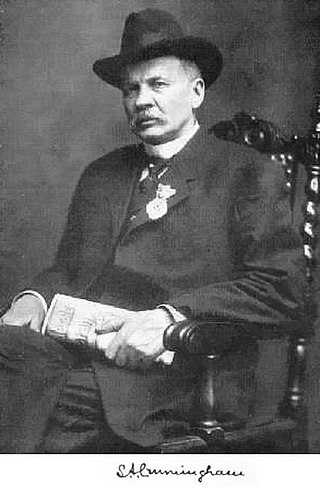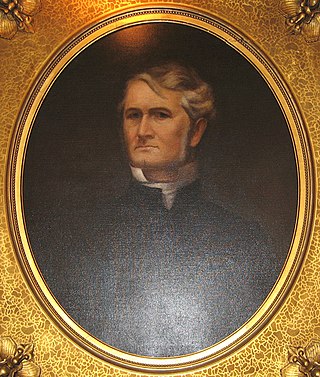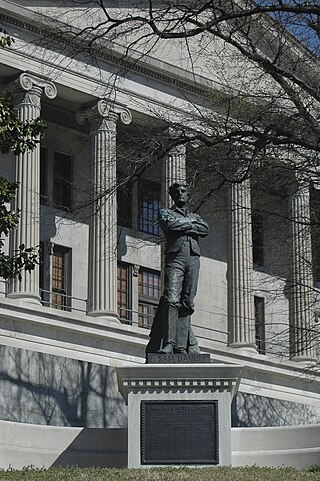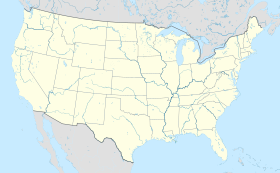
Mount Olivet Cemetery is a 206-acre (83 ha) cemetery located in Nashville, Tennessee. It is located approximately two miles East of downtown Nashville, and adjacent to the Catholic Calvary Cemetery. It is open to the public during daylight hours.

Centennial Park is a large urban park located approximately two miles west of downtown Nashville, Tennessee, United States, across West End Avenue from the campus of Vanderbilt University. The 21st-century headquarters campus of the Hospital Corporation of America was developed adjacent to the park.
The Association of Confederate Soldiers was an organization formed by veterans of the American Civil War in 1887, and helped to form the United Confederate Veterans in 1889.

The Confederate Monument in Owensboro, Ky., was a 16-foot-tall, two-part object — a 7-foot-tall bronze sculpture atop a 9-foot-tall granite pedestal — located at the southwest corner of the Daviess County Courthouse lawn, at the intersection of Third and Frederica Streets, in Owensboro, Kentucky. Nearly 122 years after the monument was dedicated in September 1900, the monument was dismantled in 2022, beginning with the removal of the sculpture in May 2022; the sculpture was placed in storage, pending a decision on what to do with it.

George Julian Zolnay was a Romanian, Hungarian, and American sculptor called the "sculptor of the Confederacy".

Springfield Park is a public park in Jacksonville, Florida, on the southern bounds of the historic neighborhood of Springfield. It is part of a network of parks that parallel Hogan's Creek.

Spirit of Commerce is a public artwork by German artist Gustav Haug located in Jackson Park, which is on the south side of Milwaukee, Wisconsin. This zinc sculpture is 15 feet tall and sits on a red granite pedestal near the park's lagoon. It is the oldest public sculpture in Milwaukee.

Sumner Archibald Cunningham was an American Confederate soldier and journalist. He was the editor of a short lived Confederate magazine called "Our Day" (1883-1884) published in New York. In 1893 he established the Confederate Veteran, a bimonthly magazine about veterans of the Confederate States Army until his death in 1913.

Cornelius Hankins (1863-1946) was an American painter. He painted agrarian landscapes of Tennessee and portraits of Confederate veterans and politicians.
Mark R. Cockrill (1788-1872) was an American cattleman, horse breeder and planter. He was the owner of a large farm in Davidson County, Tennessee and a cotton plantation with 300 slaves in Mississippi. He won many prizes for his sheep-rearing both nationally and internationally, and he became known as the "Wool King of the World". He was a multi-millionaire prior to the American Civil War, and he loaned gold to the Confederate States of America during the war.

More than 160 monuments and memorials to the Confederate States of America and associated figures have been removed from public spaces in the United States, all but five since 2015. Some have been removed by state and local governments; others have been torn down by protestors.

The Nathan Bedford Forrest Statue was a 25 feet (7.6 m) tall statue of Confederate States of America Lt. General and first-era Ku Klux Klan Grand Wizard Nathan Bedford Forrest mounted on a horse in Nashville, Tennessee, located near Interstate 65 at 701D Hogan Road. It was unveiled in 1998. The statue depicted Forrest shooting behind himself and was flanked by Confederate battle flags. Its abnormal facial features bore little resemblance to Forrest himself, and more resembled a screaming, deformed man.

The Sam Davis Statue is a historic bronze statue of Sam Davis, the "Boy Hero of the Confederacy," outside the Tennessee State Capitol in Nashville, Tennessee.
Colonel Edmund William Cole was an American Confederate veteran and businessman. He was the president of the Nashville, Chattanooga and St. Louis Railway, and the founder of the American National Bank.

The Four Southern Poets Monument, also known as the Monument to Southern Poets and Poets' Monument, is a granite monument in Augusta, Georgia, in the United States.

The United Confederate Veterans Memorial was a Confederate monument in Seattle's privately owned Lake View Cemetery, in the U.S. state of Washington. The memorial was erected by the United Daughters of the Confederacy in 1926. It was constructed of quartz monzonite from Stone Mountain, the Georgia landmark.















